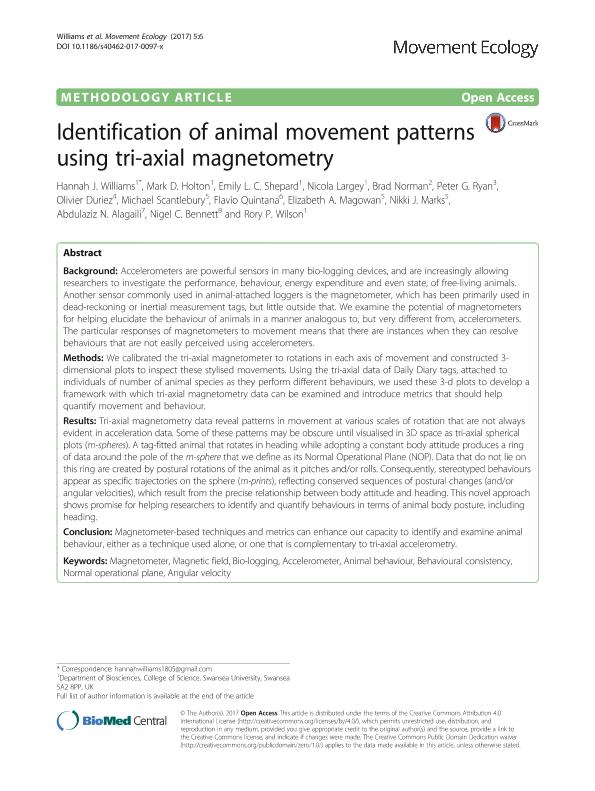Mostrar el registro sencillo del ítem
dc.contributor.author
Williams, Hannah J.
dc.contributor.author
Holton, Mark D.
dc.contributor.author
Shepard, Emily L. C.
dc.contributor.author
Largey, Nicola
dc.contributor.author
Norman, Brad
dc.contributor.author
Ryan, Peter G.
dc.contributor.author
Duriez, Olivier
dc.contributor.author
Scantlebury, Michael
dc.contributor.author
Quintana, Flavio Roberto

dc.contributor.author
Magowan, Elizabeth A.
dc.contributor.author
Marks, Nikki J.
dc.contributor.author
Alagaili, Abdulaziz N.
dc.contributor.author
Bennett, Nigel C.
dc.contributor.author
Wilson, Rory P.
dc.date.available
2018-02-26T20:39:11Z
dc.date.issued
2017-03
dc.identifier.citation
Williams, Hannah J.; Holton, Mark D.; Shepard, Emily L. C.; Largey, Nicola; Norman, Brad; et al.; Identification of animal movement patterns using tri-axial magnetometry; BioMed Central Ltd.; Movement Ecology; 5; 6; 3-2017; 1-14
dc.identifier.issn
2051-3933
dc.identifier.uri
http://hdl.handle.net/11336/37169
dc.description.abstract
Background: Accelerometers are powerful sensors in many bio-logging devices, and are increasingly allowing researchers to investigate the performance, behaviour, energy expenditure and even state, of free-living animals. Another sensor commonly used in animal-attached loggers is the magnetometer, which has been primarily used in dead-reckoning or inertial measurement tags, but little outside that. We examine the potential of magnetometers for helping elucidate the behaviour of animals in a manner analogous to, but very different from, accelerometers. The particular responses of magnetometers to movement means that there are instances when they can resolve behaviours that are not easily perceived using accelerometers. Methods: We calibrated the tri-axial magnetometer to rotations in each axis of movement and constructed 3-dimensional plots to inspect these stylised movements. Using the tri-axial data of Daily Diary tags, attached to individuals of number of animal species as they perform different behaviours, we used these 3-d plots to develop a framework with which tri-axial magnetometry data can be examined and introduce metrics that should help quantify movement and behaviour.Results: Tri-axial magnetometry data reveal patterns in movement at various scales of rotation that are not always evident in acceleration data. Some of these patterns may be obscure until visualised in 3D space as tri-axial spherical plots (m-spheres). A tag-fitted animal that rotates in heading while adopting a constant body attitude produces a ring of data around the pole of the m-sphere that we define as its Normal Operational Plane (NOP). Data that do not lie on this ring are created by postural rotations of the animal as it pitches and/or rolls. Consequently, stereotyped behaviours appear as specific trajectories on the sphere (m-prints), reflecting conserved sequences of postural changes (and/or angular velocities), which result from the precise relationship between body attitude and heading. This novel approach shows promise for helping researchers to identify and quantify behaviours in terms of animal body posture, including heading. Conclusion: Magnetometer-based techniques and metrics can enhance our capacity to identify and examine animal behaviour, either as a technique used alone, or one that is complementary to tri-axial accelerometry.
dc.format
application/pdf
dc.language.iso
eng
dc.publisher
BioMed Central Ltd.

dc.rights
info:eu-repo/semantics/openAccess
dc.rights.uri
https://creativecommons.org/licenses/by-nc-sa/2.5/ar/
dc.subject
Accelerometer
dc.subject
Angular Velocity
dc.subject
Animal Behaviour
dc.subject
Behavioural Consistency
dc.subject
Bio-Logging
dc.subject
Magnetic Field
dc.subject
Magnetometer
dc.subject
Normal Operational Plane
dc.subject.classification
Otras Ciencias Biológicas

dc.subject.classification
Ciencias Biológicas

dc.subject.classification
CIENCIAS NATURALES Y EXACTAS

dc.title
Identification of animal movement patterns using tri-axial magnetometry
dc.type
info:eu-repo/semantics/article
dc.type
info:ar-repo/semantics/artículo
dc.type
info:eu-repo/semantics/publishedVersion
dc.date.updated
2018-02-22T14:28:44Z
dc.journal.volume
5
dc.journal.number
6
dc.journal.pagination
1-14
dc.journal.pais
Reino Unido

dc.description.fil
Fil: Williams, Hannah J.. Swansea University; Reino Unido
dc.description.fil
Fil: Holton, Mark D.. Swansea University; Reino Unido
dc.description.fil
Fil: Shepard, Emily L. C.. Swansea University; Reino Unido
dc.description.fil
Fil: Largey, Nicola. Swansea University; Reino Unido
dc.description.fil
Fil: Norman, Brad. Ecocean Inc. (aust.); Australia
dc.description.fil
Fil: Ryan, Peter G.. University of Cape Town; Sudáfrica
dc.description.fil
Fil: Duriez, Olivier. Université Paul-Valéry Montpellier; Francia
dc.description.fil
Fil: Scantlebury, Michael. The Queens University of Belfast; Irlanda
dc.description.fil
Fil: Quintana, Flavio Roberto. Consejo Nacional de Investigaciones Científicas y Técnicas. Centro Nacional Patagónico; Argentina
dc.description.fil
Fil: Magowan, Elizabeth A.. The Queens University of Belfast; Irlanda
dc.description.fil
Fil: Marks, Nikki J.. The Queens University of Belfast; Irlanda
dc.description.fil
Fil: Alagaili, Abdulaziz N.. King Saud University; Arabia Saudita
dc.description.fil
Fil: Bennett, Nigel C.. University of Pretoria; Sudáfrica
dc.description.fil
Fil: Wilson, Rory P.. Swansea University; Reino Unido
dc.journal.title
Movement Ecology
dc.relation.alternativeid
info:eu-repo/semantics/altIdentifier/doi/http://dx.doi.org/10.1186/s40462-017-0097-x
dc.relation.alternativeid
info:eu-repo/semantics/altIdentifier/url/https://movementecologyjournal.biomedcentral.com/articles/10.1186/s40462-017-0097-x
Archivos asociados
